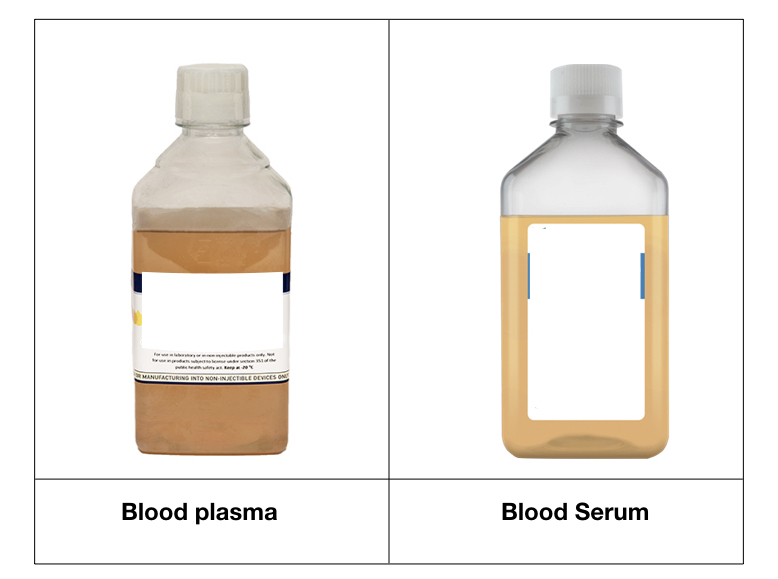Two important parts of the human blood are plasma and serum, which have a major portion of water, protein and other biomolecules. Still, serum and plasma are different in many ways and have different applications.
Why do we need to understand the differences and similarities between plasma vs serum?
Because both have an important role in animal tissue culture, biotechnology experiments and diagnostics. First, before going ahead we need to understand the blood; its composition and its importance.
Our blood is red in color, thanks to the RBCs- red blood cells having three important ingredients- RBC, WBC (white blood cells) and platelets. And of course water.
Put simply, it delivers nutrients, water and oxygen to various body parts.
When centrifuge the blood, plasma and serum got separate. Plasm is used for blood transfusion while serum is used in the tissue culture or cell culture.
We are more interested in serum, because of its use in tissue culture, and karyotyping and that’s what our blog is all about.
Henceforth, to make our fundaments clear on serum, this article is important, Here is the article illustrates major differences and some similarities between serum vs plasma.

Serum vs plasma differences:
Definition:
An undiluted, liquid, yellowish portion employed for tissue culture is referred to as serum. While
The transparent, thick fluid used for blood transfusion is referred to as plasma.
Color:
The serum is a yellowish clear solution while the plasma is straw-colored liquid.
Extraction:
The serum and plasma extraction process is much similar, however, there are minute differences.
To extract serum, first, the blood is isolated and allow to clot for 15 to 30 minutes at room temperature. The sample is allowed to centrifuge which separates the solid and liquid apart.
Fibrin and other cell debris remain at the bottom while the serum is isolated from the top.
Using the sterile pipette, the yellowish fluid part is collected in the fresh tube- our serum.
The extraction process of plasma as we said, is similar, here an anticoagulant is added to prevent blood clotting.
After adding an anticoagulant, blood allows to centrifuge and the liquid portion is collected using the pipette in a sterile tube. It is our plasma.
Key difference:
Now coming to the key difference between serum vs plasma. If the extraction process, steps and final product collected are the same, then what is the difference?
When blood clots, fibrinogen converts into fibrin and remains in cell debris, at the bottom, during centrifugation, and that is our serum.
When blood isn’t allowed to clot fibrinogen remains in the liquid portion that is our plasma.
The catch!
So technically serum is when fibrinogen is removed from the liquid (plasma – fibrinogen); while, when fibrinogen remains in the liquid, is our plasma (serum + fibrinogen).
Plasma contains an extra ingredient as fibrinogen than serum. So the question strikes in mind what are the other components of either?
Components of serum and plasma:
Typically serum and plasma are liquid portions of the blood and henceforth, the major part of it is water; 90% in serum and 95% in plasma. Besides other components are nutrients, proteins, electrolytes, hormones and immunoglobulins in serum and nutrients, proteins, electrolytes, immunoglobulins, hormones and fibrinogens in plasma.
Function:
The serum is a part of plasma and provides nutrients in different parts of the body while the plasma delivers oxygen and collected waste material from different body parts and cells.
It continuously circulates throughout our body; regulates blood pressure and blood volume.
An important component plasma carry is the fibrinogen which again performs a crucial function to clot the blood. Without it, blood flow can’t be stopped from the site of a wound.
Hence it helps in wound healing and prevents internal and external bleeding (which is life-threatening).
Volume:
How much portion of the blood are plasma and serum? One may wonder. When extracting, the volume of serum obtained is lower than plasma. Typically the 55% blood volume is plasma.
While the volume of serum is lesser than 55%.
Medical applications:
One of the most common applications of serum is in cell culture. The serum- a liquid rich in nutrients is a secondary ingredient of a cell culture media. It is used to induce cell proliferation and differentiation.
It is used in wide varieties of fields, some of its common applications are
- Biotechnology and genetic research
- Medical diagnostics and testing
- Genetic testing and gene therapy
- Pharmaceutical
- Cancer and stem cell research
- The serum is also used as an antiserum to produce different immunoglobulins against different pathogens.
- Also, direct serum testing helps in encountering diseases, such as Paget’s disease, prostate cancer, hepatitis and AIDS.
If you wish to learn more on the present topic you can read our previous article on this topic: What is FBS (Fetal Bovine Serum)?- Definition, Processing, Benefits, Applications and Limitations.
- The serum is also used to check the blood group of a person as it contains different antigens and antibodies.
- Test such as cholesterol, protein, sugar and hCG in the blood can be performed using the serum.
- Interestingly, animal serum (more precisely “animal sera”) are used as anti-toxins and anti-venom.
- On the other side, blood plasma is extensively used in blood transfusion.
- In case of blood loss, shock, trauma, burn and anemia, using plasma can increase the blood volume. Life can be saved by donating plasma.
- It is also used as a therapy to treat varied hematological and non-hematological conditions, for example, hemophilia.
Density:
The density of serum and plasma is also most similar with 1.024 g/ml snd 1.025 g/ml for serum and plasma, respectively.
Read external article on present topic: Plasma vs serum.
Quick summary:
| Serum | Plasma | |
| Definition | A serum is a liquid portion of the blood extracted when blood clots. | Plasma is a liquid portion of the blood obtained after adding an anticoagulant. |
| Composition | Protein, hormones, electrolytes, immunoglobulins and nutrients | Proteins, hormones, electrolytes, immunoglobulins, fibrinogens and waste products. |
| Fibrinogen | Absent | Present |
| Blood clotting | Allowed | Not- allowed |
| Anticoagulant | Not added | Added |
| Water portion | 90% | 95% |
| Volume | Less than plasma | 55% of total blood |
| Applications | Tissue and cell cultureAs an antivenom Blood grouping Testing some disease condition | Blood transfusion |
| Storage | Aseptically at -8°C to -20°C | Aseptically at -8°C to -20°C |
How to isolate serum?
- Take a fresh blood sample or blood in a plain tube.
- Allow to clot it for 15 to 30 minutes or until, a yellowish liquid appears on the top.
- Take tubes and centrifuge at 3000rpm for 15 to 20 minutes.
- Carefully remove tubes from the centrifuge and collect the liquid portion without disturbing the debris.
- Cap the tubes and preserve them at -20°C temperature in the deep freeze.
- Note that steps like filtration, eradication and dialysis are also performed to purify the final product.
How to isolate plasma?
- Collect the fresh blood sample in an EDTA tube, EDTA is an anticoagulant.
- Allow it to settle for 15 to 30 minutes and centrifuge at 3000 rpm for 20 minutes.
- Collect the liquid portion of the sample without disturbing the bottom and store it at -20°C temperature.
Read more: What is an Isochromosome?- Definition, Mechanism and Aberrations.
Conclusion:
Though the process of extracting palsma and serum is almost similar, the final product is different. Although in recent times, commercially available plasma and serum are more preferred by scientists. It is very important to check the purity and quality of sera and plasma before use.
many testing are available to check the purity and quality of both. Always prefer to use FDA approve product for your experiments and store in sterile place under sterile conditions.


